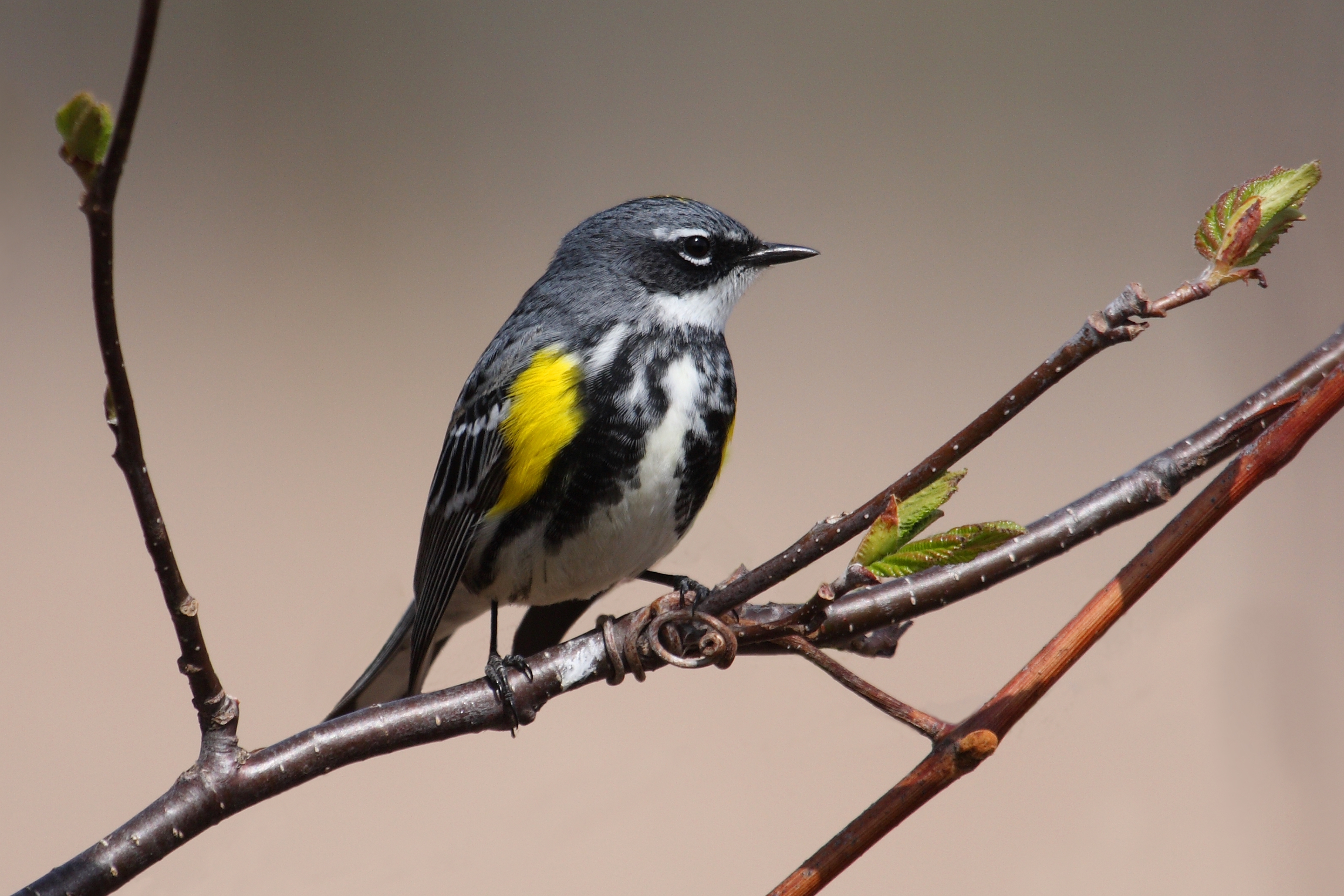In Mississippi, during the spring and summer seasons, the arrival of orioles, tanagers, and various species of warblers brings about the common occurrence of yellow birds, particularly yellow-rumped warblers and American goldfinches. However, as winter sets in, these summer species migrate out while yellow-rumped warblers and American goldfinches migrate in, seeking warmer weather.
To assist you in identifying the yellow birds you spot in Mississippi, this guide provides pictures, identification information, song recordings, as well as details about their migration patterns.
The majority of yellow birds found in Mississippi belong to the warbler, oriole, or tanager families. In some cases, female birds may exhibit distinct appearances compared to the males of their species.
By utilizing the comprehensive information within this guide, identifying yellow birds will become much simpler. The following list presents the yellow birds commonly observed in Mississippi during spring and summer (May and June), according to eBird checklists:
Yellow birds in Mississippi throughout the year: Pine Warbler, Eastern Meadowlark
Yellow birds in Mississippi during summer: White-eyed Vireo, Common Yellowthroat, Summer Tanager, Orchard Oriole, Prothonotary Warbler, Hooded Warbler, Yellow-throated Vireo, Yellow-throated Warbler, Prairie Warbler, Dickcissel, Baltimore Oriole, Painted Bunting
Yellow birds in Mississippi during winter: Yellow-rumped Warbler, American Goldfinch, Cedar Waxwing, Palm Warbler, Orange-crowned Warbler, Western Kingbird, Western Meadowlark, Yellow-headed Blackbird, Evening Grosbeak
Yellow birds in Mississippi during migration: American Redstart, Yellow Warbler, Magnolia Warbler, Scarlet Tanager, Black-throated Green Warbler, Blue-winged Warbler, Nashville Warbler, Canada Warbler, Wilson’s Warbler, Cape May Warbler
Continue reading to identify the yellow birds you have spotted.
33 Yellow Birds in Mississippi:
1. Yellow-rumped Warbler
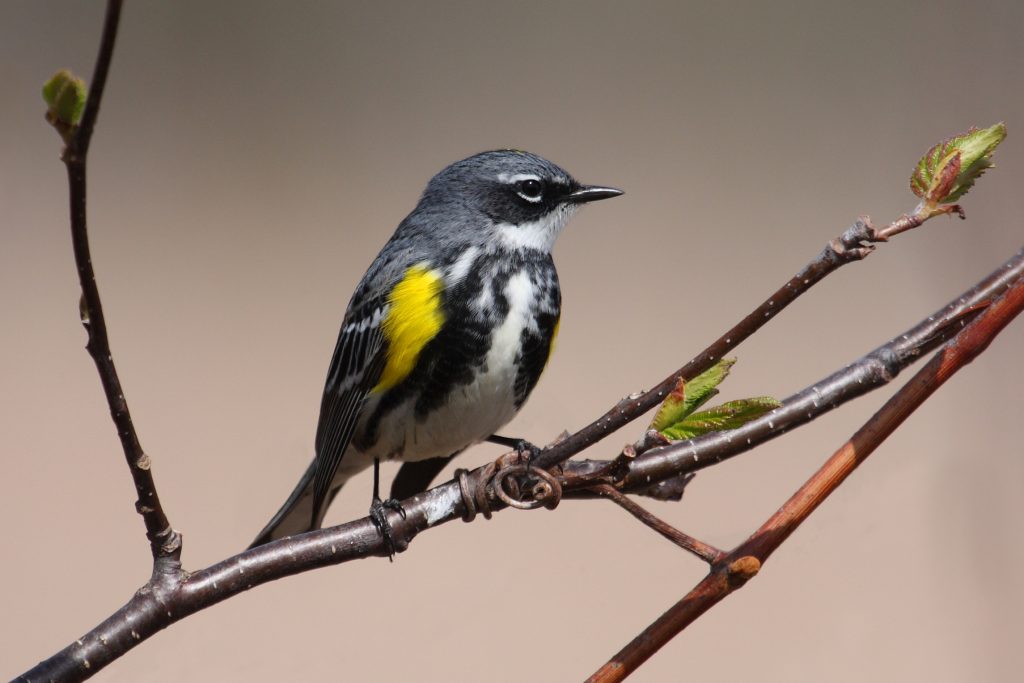
The yellow-rumped warbler, also known as Setophaga coronata, is a winter bird in Mississippi. It typically arrives in September and some individuals stay until May. However, the best months to spot them are from October to April. These warblers are present in 36% of winter checklists submitted by birdwatchers in the state.
Yellow-rumped warblers exhibit a gray coloration with bursts of yellow on their face, sides, and rump. They also have white wings. During the breeding season, females may appear slightly brown, while winter birds have a paler brown color with vibrant yellow rumps and sides that transition back to yellow and gray in spring.
With a length of 4.7-5.5 inches (12-14 cm) and a weight of 0.4-0.5 ounces (12-13 g), yellow-rumped warblers predominantly breed in Canada, the Rockies, and the Appalachian mountains.
During migration, they can be spotted in the Midwest before migrating to southern and southwestern US states, the Pacific Coast, Mexico, and Central America.
These warblers can be found in coniferous forests, especially during the breeding season. In winter, they inhabit open areas with fruiting shrubs. Their diet primarily consists of insects during summer and migration, while they primarily feed on fruit, including bayberry and wax myrtle, during winter.
If you wish to attract yellow-rumped warblers to your backyard, consider providing sunflower seeds, suet, raisins, and peanut butter.
Interesting fact: Yellow-rumped warblers form large flocks, sometimes numbering in the thousands, during the winter. They can display aggressiveness towards other species that come too close.
2. Pine Warbler
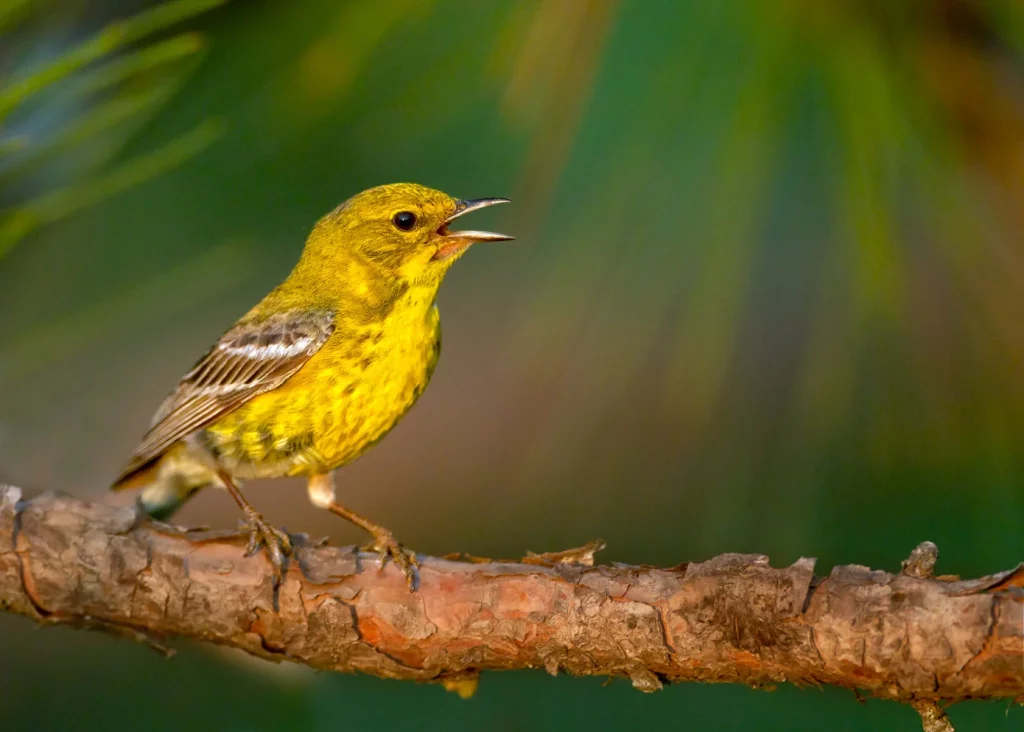
The pine warbler (Setophaga pinus) is a yellow bird commonly found in Mississippi throughout the year. It is a small songbird with a length of about 5.5 inches (14 cm) and weighs around 0.4-0.5 ounces (11-14 g).
Male pine warblers have bright yellow plumage, while females and young birds are more olive-yellow in color. They have thin pointed bills and white wing bars. Pine warblers have a distinctive song consisting of trills and musical notes.
As their name suggests, pine warblers are often found in pine forests, where they forage for insects, spiders, and seeds. During the breeding season, they build cup-shaped nests in pine trees. In winter, they may also visit backyard feeders for suet, peanut butter, and seeds.
3. Eastern Meadowlark
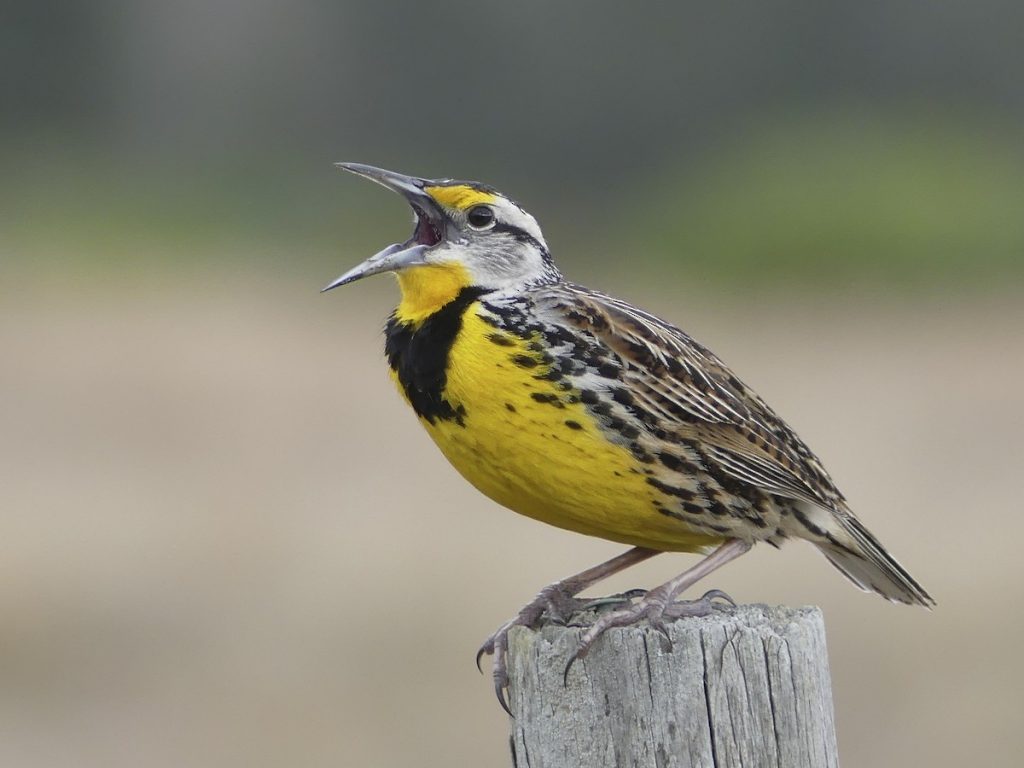
The eastern meadowlark (Sturnella magna) is a yellow-breasted bird that can be found in Mississippi throughout the year. It is a medium-sized bird with a length of about 9.5-11 inches (24-28 cm) and weighs around 4-6 ounces (110-170 g).
Eastern meadowlarks have bright yellow underparts with brown streaking on their upperparts. They have a distinctive black “V” on their chest and a long pointed bill. They are known for their melodious and flute-like song, which is often heard during the breeding season.
These birds inhabit grasslands, meadows, and agricultural fields, where they forage for insects, spiders, seeds, and small fruits. They build cup-shaped nests on the ground and lay eggs in them.
4. White-eyed Vireo
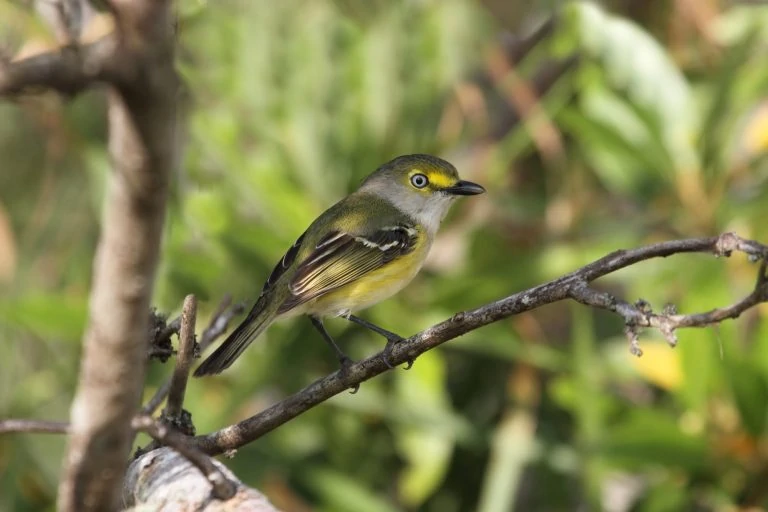
The white-eyed vireo (Vireo griseus) is a small songbird that can be found in Mississippi during the summer months. It has a length of about 4.5-5 inches (11-13 cm) and weighs around 0.4-0.5 ounces (11-14 g).
White-eyed vireos have olive-green upperparts, yellow underparts, and a distinctive white eye-ring. They have a chunky body, a hooked bill, and a short tail. They are known for their lively and varied songs, often characterized by phrases such as “quick, see me, I’m here.”
These vireos inhabit shrubby areas, thickets, and woodland edges. They primarily feed on insects, spiders, and berries. During the breeding season, they build cup-shaped nests in dense vegetation.
5. Common Yellowthroat
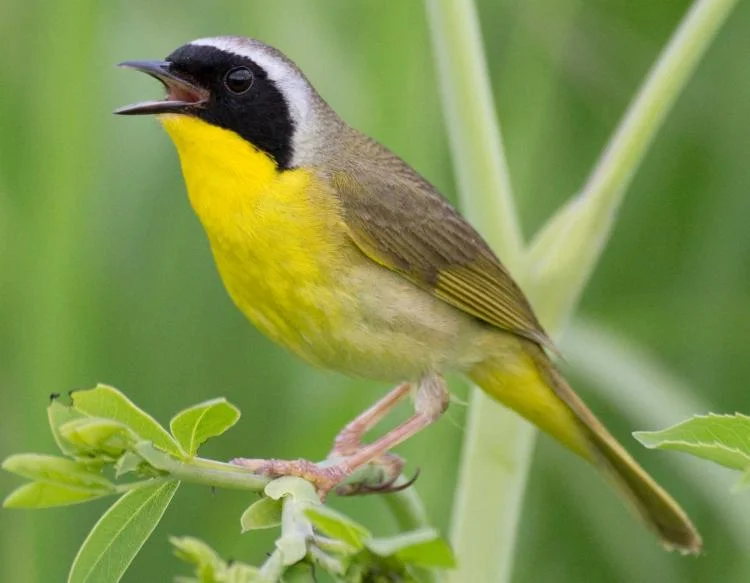
The common yellowthroat (Geothlypis trichas) is a small migratory bird that can be found in Mississippi during the summer months. It has a length of about 4.7 inches (12 cm) and weighs around 0.3-0.4 ounces (9-12 g).
Male common yellowthroats have bright yellow underparts with a black mask across their face. Females have a similar color pattern but with a duller yellow coloration. They have a relatively short tail and a slender bill.
These birds inhabit marshes, wetlands, and thickets near water. They feed on insects, spiders, and small fruits. During the breeding season, they build cup-shaped nests in low vegetation.
These are just a few examples of yellow birds you may encounter in Mississippi. Remember to observe their physical characteristics, behavior, and habitat to help with identification. Enjoy your birdwatching adventures!
6. American Goldfinch
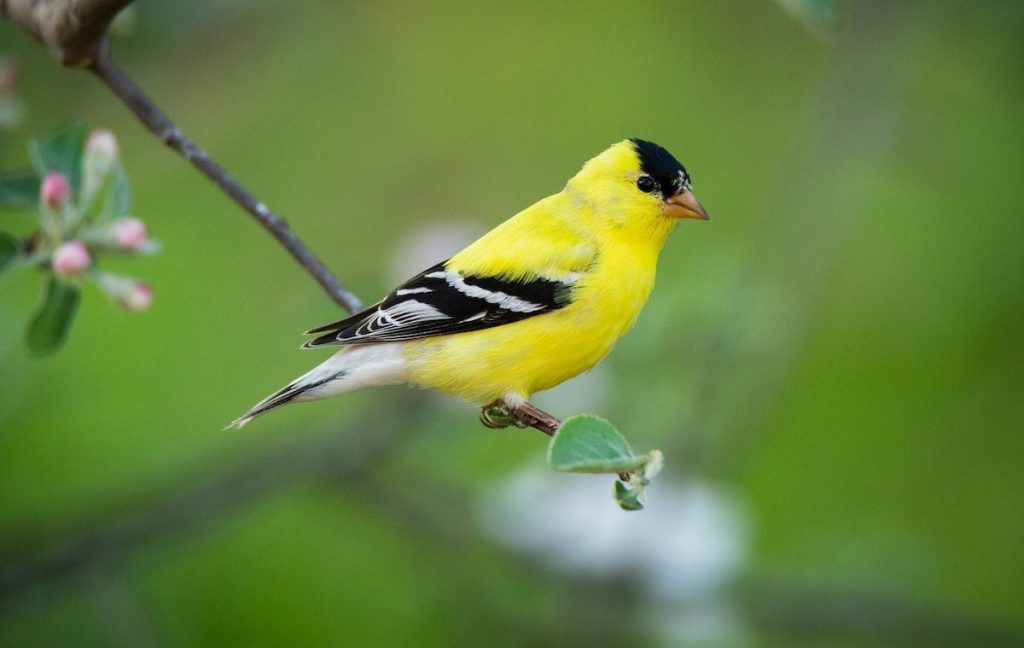
The American goldfinch (Spinus tristis) is a small songbird that can be found in Mississippi year-round. It is about 4.5-5 inches (11-13 cm) long and weighs around 0.4-0.7 ounces (11-20 g).
During the breeding season, male American goldfinches have bright yellow plumage with black wings and a black cap on their head. In contrast, females and non-breeding males have a more subdued olive-brown coloration. They have a conical bill and a short notched tail.
These goldfinches are commonly found in open fields, meadows, and gardens, where they feed on seeds from plants such as thistles and sunflowers. They are known for their undulating flight pattern and sweet, twittering song.
7. Yellow-billed Cuckoo

The yellow-billed cuckoo (Coccyzus americanus) is a medium-sized bird that can be found in Mississippi during the summer months. It measures about 11-12 inches (28-30 cm) in length and weighs around 1.5-2.5 ounces (42-70 g).
Yellow-billed cuckoos have a long, slender body with a gray-brown coloration and a distinctive yellow bill. They have a white belly and a long tail with white spots on the underside. They are known for their distinctive “cu-cu-cu” call.
These cuckoos inhabit woodlands, thickets, and riparian areas near water. They primarily feed on insects, especially caterpillars. They build platform nests made of twigs and lay their eggs in the nests of other bird species.
8. Prothonotary Warbler
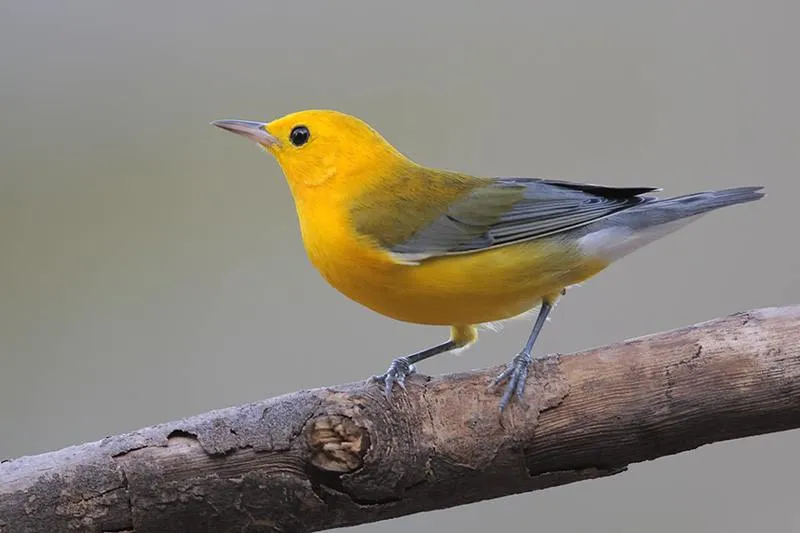
The prothonotary warbler (Protonotaria citrea) is a small migratory bird that can be found in Mississippi during the summer months. It measures about 4.5-5 inches (11-13 cm) in length and weighs around 0.3-0.4 ounces (9-12 g).
Male prothonotary warblers have bright yellow plumage with a gray-blue back and wings. They have a long, thin bill and a relatively short tail. Females have a similar color pattern but with a duller yellow coloration.
These warblers inhabit swamps, wetlands, and wooded areas near water. They forage for insects, spiders, and small crustaceans. They build cup-shaped nests in tree cavities or artificial nest boxes.
9. Yellow-throated Warbler
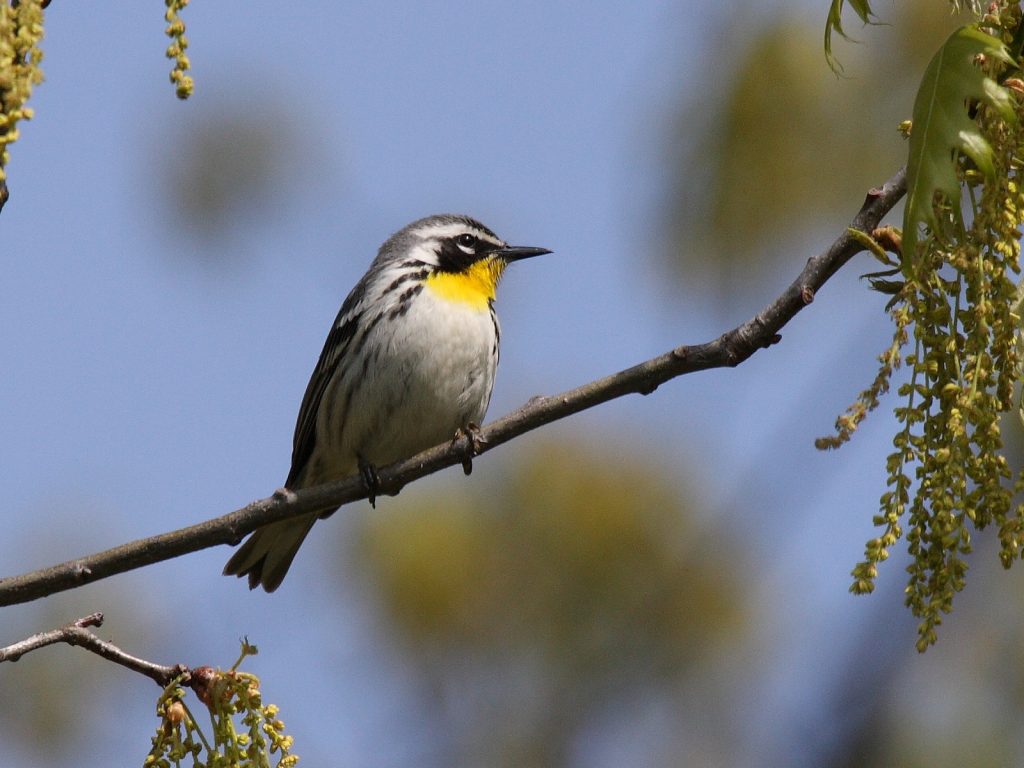
The yellow-throated warbler (Setophaga dominica) is a small migratory bird that can be found in Mississippi during the summer months. It measures about 4.5-5 inches (11-13 cm) in length and weighs around 0.3-0.4 ounces (9-12 g).
Male yellow-throated warblers have yellow underparts with a black mask across their face and a distinctive yellow throat. They have a gray-blue back and wings, a long pointed bill, and a slender body. Females have a similar color pattern but with a duller yellow coloration.
These warblers inhabit mature forests, particularly near water. They primarily feed on insects, spiders, and small fruits. They build cup-shaped nests in trees, usually near the end of branches.
These additional yellow birds in Mississippi provide more opportunities for birdwatchers to appreciate the diversity of avian life in the region. Enjoy your birdwatching endeavors and the beauty of these vibrant yellow species!
Certainly! Here are a few more yellow birds that can be found in Mississippi:
10. Yellow Warbler
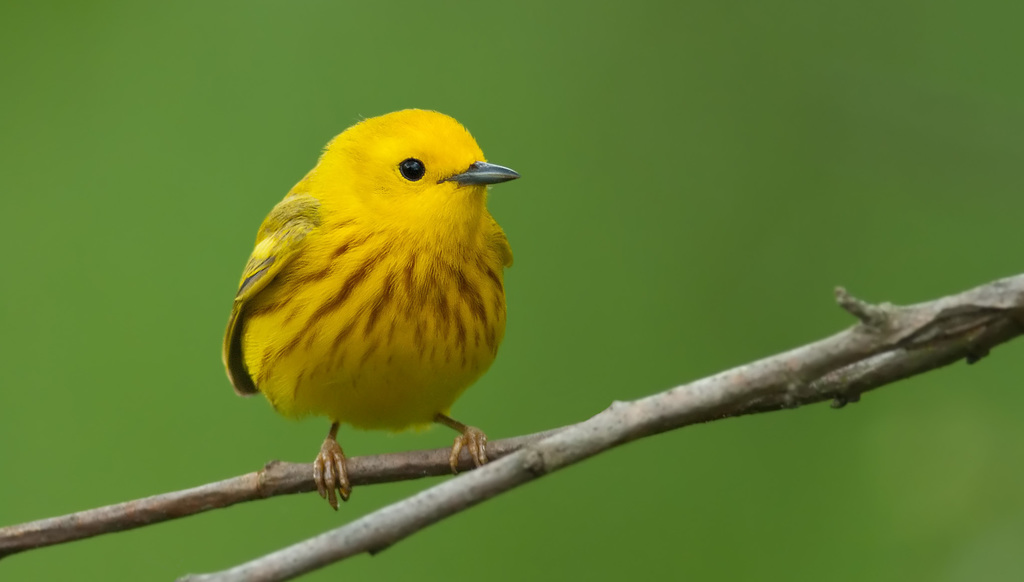
The yellow warbler (Setophaga petechia) is a small migratory bird that can be found in Mississippi during the summer months. It measures about 4.7 inches (12 cm) in length and weighs around 0.3 ounces (8 grams).
Male yellow warblers have bright yellow plumage with reddish streaks on their chest and a touch of rusty color on their crown. Females have a duller yellow coloration. They have a slender body, a thin pointed bill, and a relatively long tail.
These warblers inhabit a variety of habitats, including forests, wetlands, and gardens. They feed on insects, spiders, and small berries. They build cup-shaped nests in shrubs or trees, often near water.
11. Yellow-breasted Chat
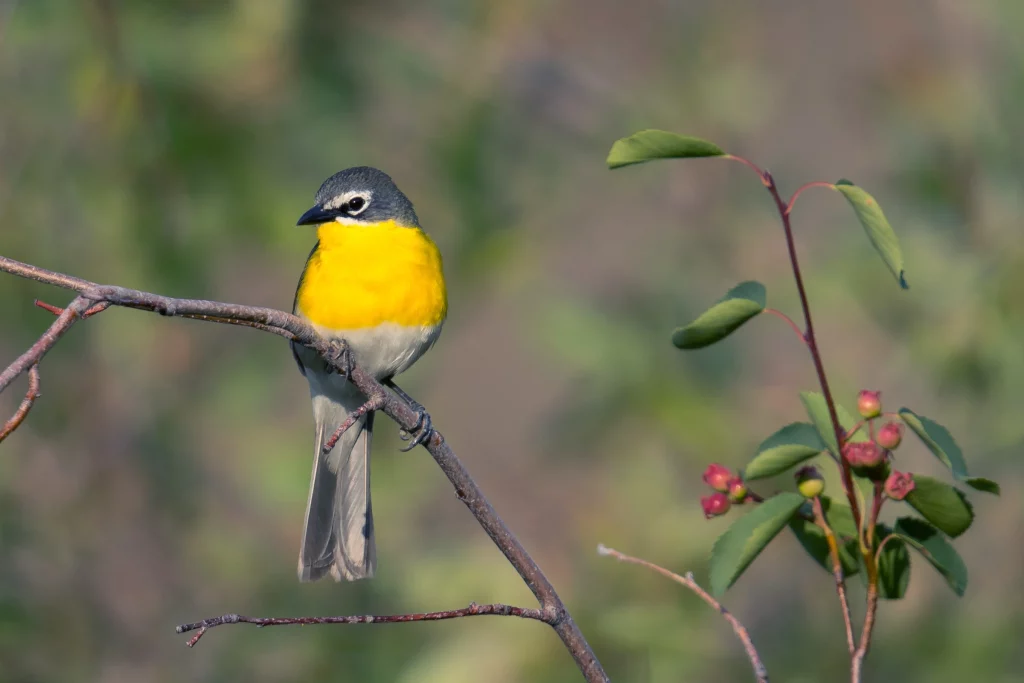
The yellow-breasted chat (Icteria virens) is a medium-sized migratory bird that can be found in Mississippi during the summer months. It measures about 7-7.5 inches (18-19 cm) in length and weighs around 1.1-1.6 ounces (31-45 grams).
Yellow-breasted chats have a unique appearance with a bright yellow breast, olive-green upperparts, and a grayish head. They have a stout bill and a long tail. They are known for their loud and varied song, which often includes mimicry of other bird species.
These chats inhabit thickets, shrubby areas, and woodland edges. They feed on insects, fruits, and berries. They build bulky cup-shaped nests in shrubs or low trees.
12. Northern Parula
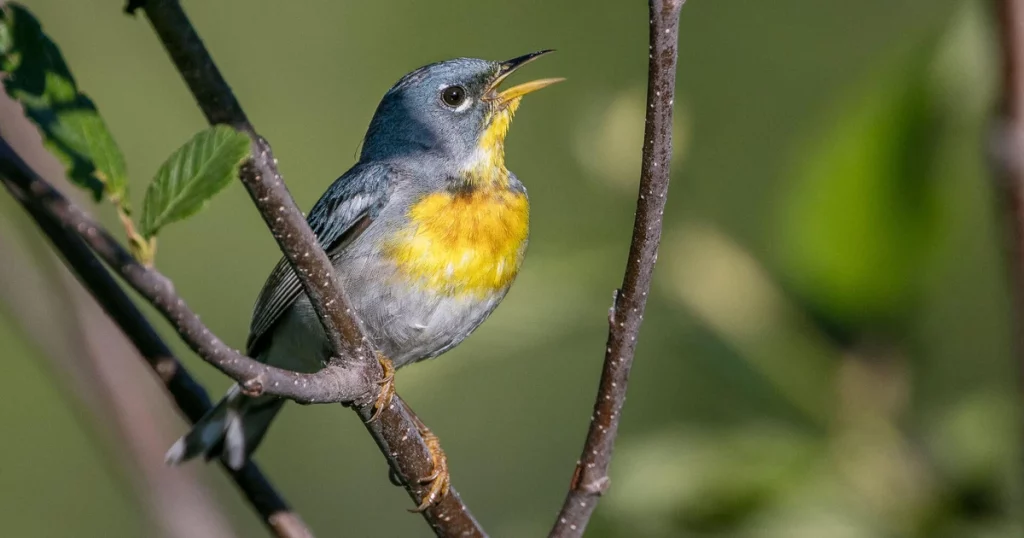
The northern parula (Setophaga americana) is a small migratory bird that can be found in Mississippi during the breeding season. It measures about 4.3-4.7 inches (11-12 cm) in length and weighs around 0.3-0.4 ounces (8-11 grams).
Male northern parulas have bluish-gray upperparts, a yellow throat, and a patch of orange on their breast. They have a short, thin bill and a relatively short tail. Females have a similar color pattern but with a duller yellow coloration.
These warblers inhabit mixed forests, swamps, and wooded areas near water. They feed on insects and spiders. They build small cup-shaped nests made of moss and bark, usually suspended from tree branches.
These additional yellow birds add to the diverse avian population in Mississippi and offer more opportunities for bird enthusiasts to observe and appreciate their unique characteristics. Happy birdwatching!
Certainly! Here are more yellow birds that can be found in Mississippi:
13. Prothonotary Warbler
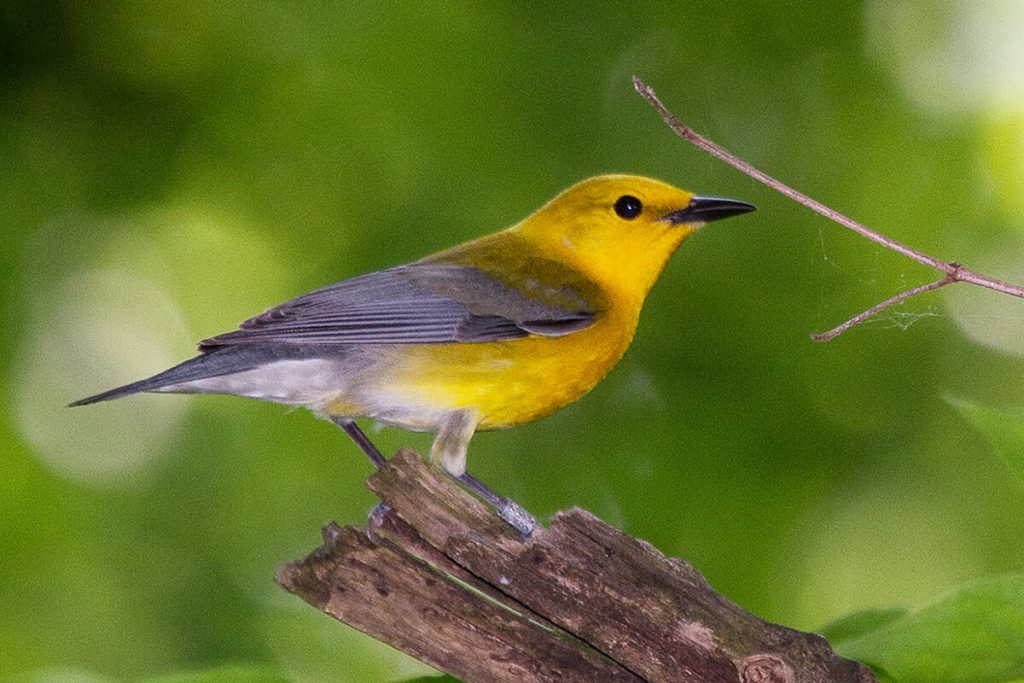
The prothonotary warbler (Protonotaria citrea) is a small migratory bird that can be found in Mississippi during the breeding season. It measures about 4.7-5.1 inches (12-13 cm) in length and weighs around 0.4-0.5 ounces (11-14 grams).
Male prothonotary warblers have bright yellow plumage, a blue-gray back, and a distinctive orange crown. They have a sturdy bill and a relatively long tail. Females have a duller yellow coloration.
These warblers inhabit swamps, wetlands, and bottomland forests near water. They feed on insects and spiders, often foraging low near the water’s surface. They build cup-shaped nests in tree cavities or nest boxes.
14. Common Yellowthroat
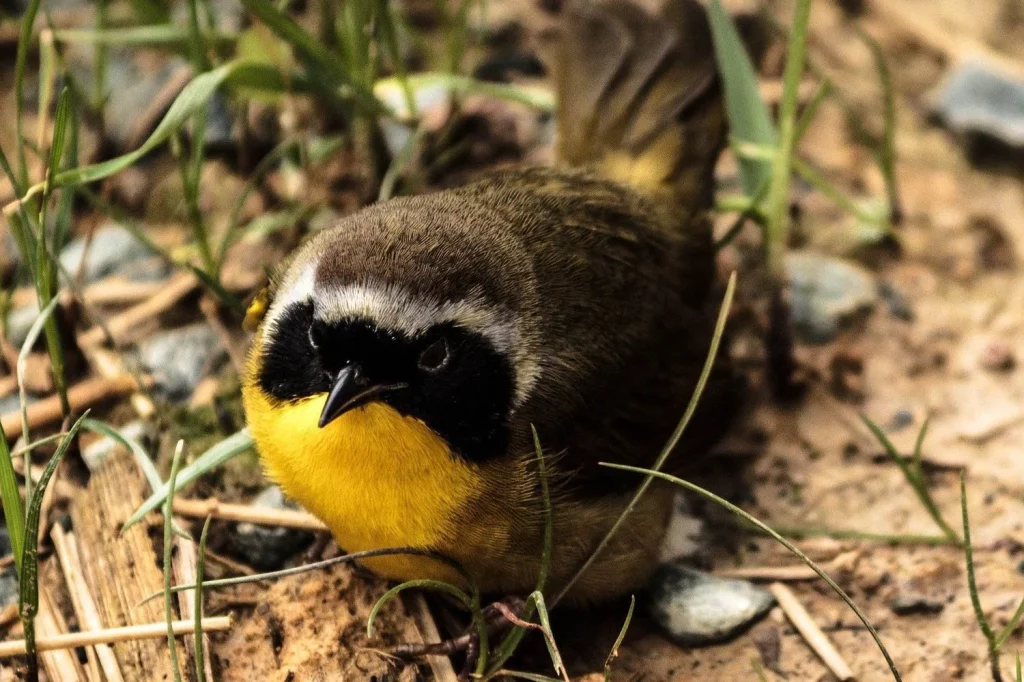
The common yellowthroat (Geothlypis trichas) is a small migratory bird that can be found in Mississippi during the breeding season. It measures about 4.3-5.1 inches (11-13 cm) in length and weighs around 0.3-0.4 ounces (9-12 grams).
Male common yellowthroats have a yellow face and throat with a black mask that extends from the eyes to the sides of the neck. They have olive-green upperparts and a relatively long tail. Females have a similar color pattern but with a duller yellow coloration.
These warblers inhabit marshes, wetlands, and shrubby areas. They feed on insects and spiders, often foraging in dense vegetation. They build cup-shaped nests on or near the ground.
15. American Goldfinch
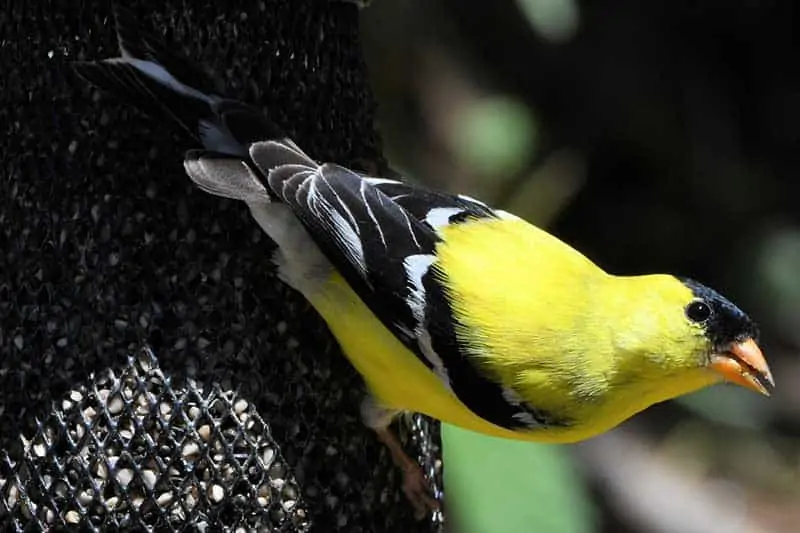
The American goldfinch (Spinus tristis) is a small resident bird that can be found in Mississippi throughout the year. It measures about 4.3-5.1 inches (11-13 cm) in length and weighs around 0.4-0.6 ounces (12-17 grams).
Male American goldfinches have bright yellow plumage during the breeding season, while females have a duller yellow coloration. They have a conical bill and a relatively long tail. In the winter, both males and females adopt a more olive-brown plumage.
These finches inhabit open fields, meadows, and gardens. They feed primarily on seeds, especially from thistles and other composite plants. They build cup-shaped nests in trees or shrubs.
16. Eastern Meadowlark
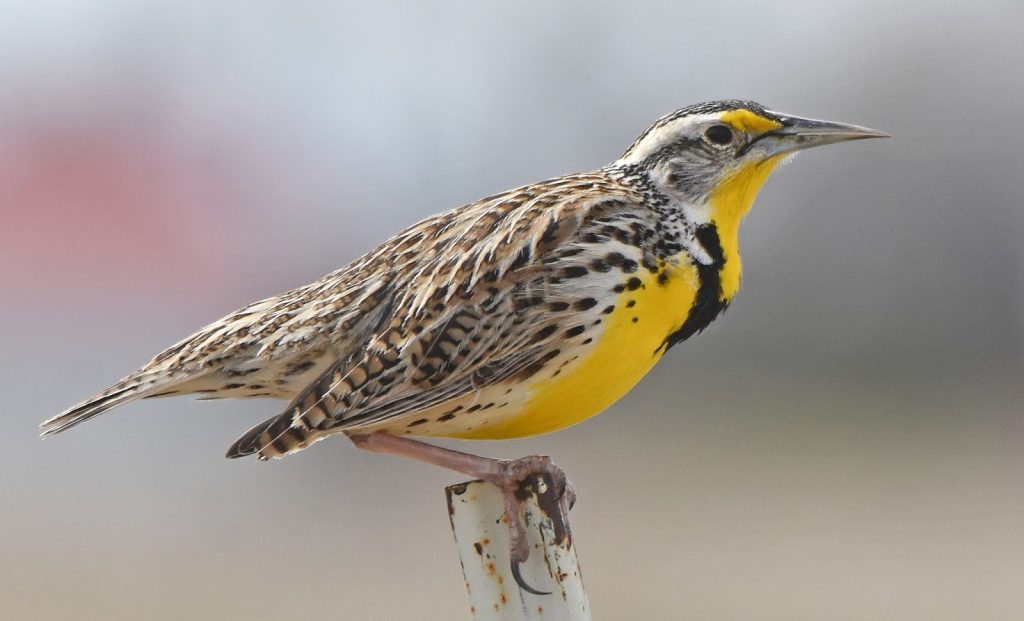
The eastern meadowlark (Sturnella magna) is a medium-sized resident bird that can be found in Mississippi throughout the year. It measures about 7.5-10 inches (19-25 cm) in length and weighs around 4-6 ounces (113-170 grams).
Eastern meadowlarks have a bright yellow belly and throat with black V-shaped markings on their chest. They have a brown back, a stout bill, and a relatively short tail. They are known for their melodious song, often heard from a prominent perch.
These birds inhabit grasslands, meadows, and agricultural fields. They feed on insects, earthworms, and seeds. They build cup-shaped nests on the ground, often hidden in tall grasses.
17. Yellow-billed Cuckoo

The yellow-billed cuckoo (Coccyzus americanus) is a medium-sized migratory bird that can be found in Mississippi during the breeding season. It measures about 11-12 inches (28-30 cm) in length and weighs around 1.6-2.4 ounces (45-68 grams).
Yellow-billed cuckoos have a long, slender
body with a mainly grayish-brown plumage. They have a distinctive yellow bill, a reddish eye ring, and a long tail with white spots. They are known for their unique “coo-coo-coo” call.
These cuckoos inhabit deciduous forests, riparian areas, and wooded swamps. They feed primarily on insects, especially caterpillars. They build platform nests made of twigs, often in dense foliage.
These are some more yellow birds that can be found in Mississippi, adding to the region’s vibrant bird population. Enjoy your birdwatching adventures!
Certainly! Here are more yellow birds that can be found in Mississippi:
18. Yellow-throated Vireo

The yellow-throated vireo (Vireo flavifrons) is a small migratory bird that can be found in Mississippi during the breeding season. It measures about 5.5-5.9 inches (14-15 cm) in length and weighs around 0.4-0.5 ounces (11-14 grams).
Yellow-throated vireos have a bright yellow throat and upper breast, with olive-green upperparts and a white belly. They have a stout bill and a relatively short tail. Their song consists of a series of repeated phrases.
These vireos inhabit deciduous forests, especially near water. They feed on insects and occasionally fruits. They build cup-shaped nests in the fork of tree branches.
19. Yellow-breasted Chat
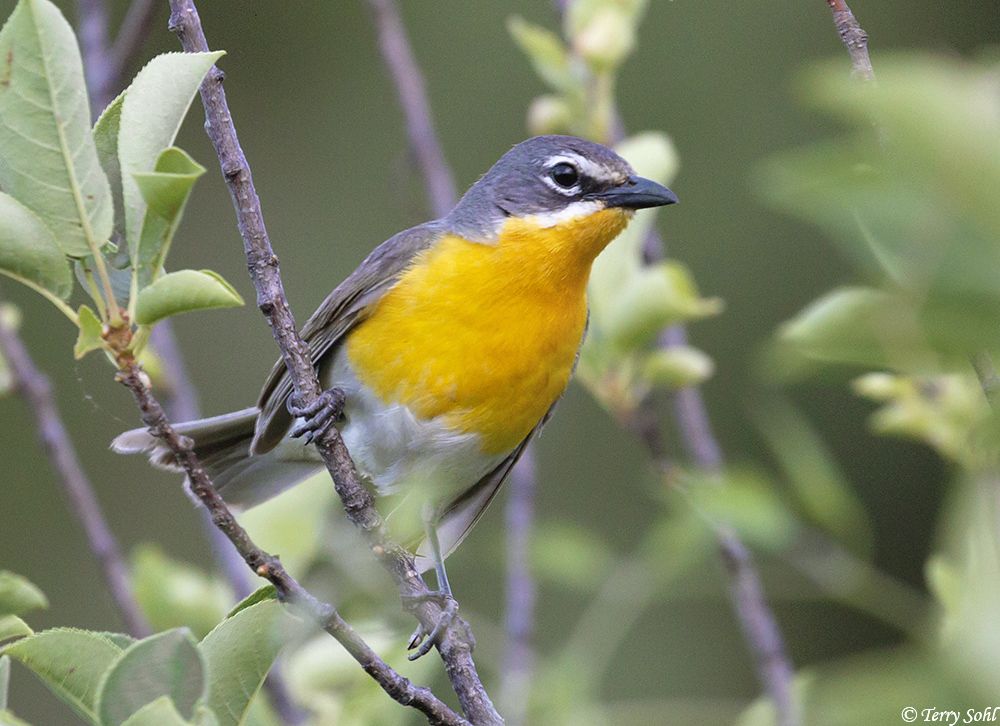
The yellow-breasted chat (Icteria virens) is a medium-sized migratory bird that can be found in Mississippi during the breeding season. It measures about 6.7-7.5 inches (17-19 cm) in length and weighs around 0.8-1.1 ounces (23-31 grams).
Yellow-breasted chats are known for their distinctive and loud songs, consisting of a variety of musical and harsh notes. They have a yellow breast, olive-green upperparts, and a relatively long tail. They also have a thick bill.
These chats inhabit dense thickets, shrubby areas, and forest edges. They feed on insects, spiders, and berries. They build cup-shaped nests hidden in dense vegetation.
20. Yellow-headed Blackbird
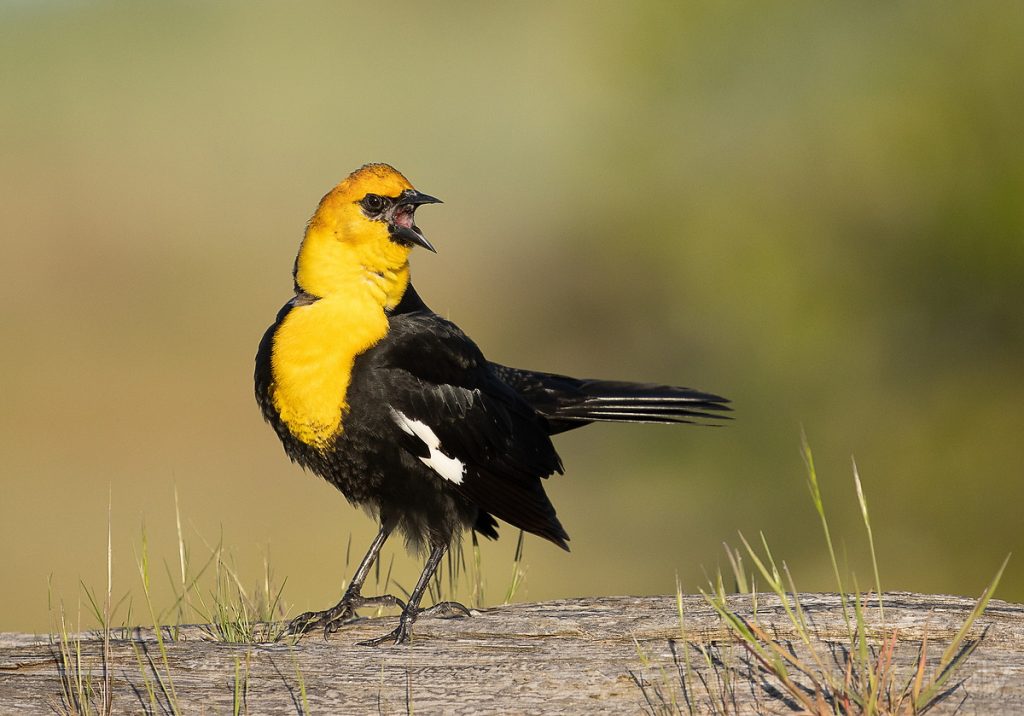
The yellow-headed blackbird (Xanthocephalus xanthocephalus) is a medium-sized migratory bird that can be found in Mississippi during the breeding season. It measures about 9.1-10.2 inches (23-26 cm) in length and weighs around 3.4-5.1 ounces (96-145 grams).
Male yellow-headed blackbirds have a striking black body with a bright yellow head and neck. Females have a duller brownish coloration with yellowish streaks. They have a conical bill and a relatively long tail.
These blackbirds inhabit wetlands, marshes, and grassy areas near water. They feed on insects, seeds, and grains. They build cup-shaped nests suspended from cattails or other vegetation.
21. Orchard Oriole
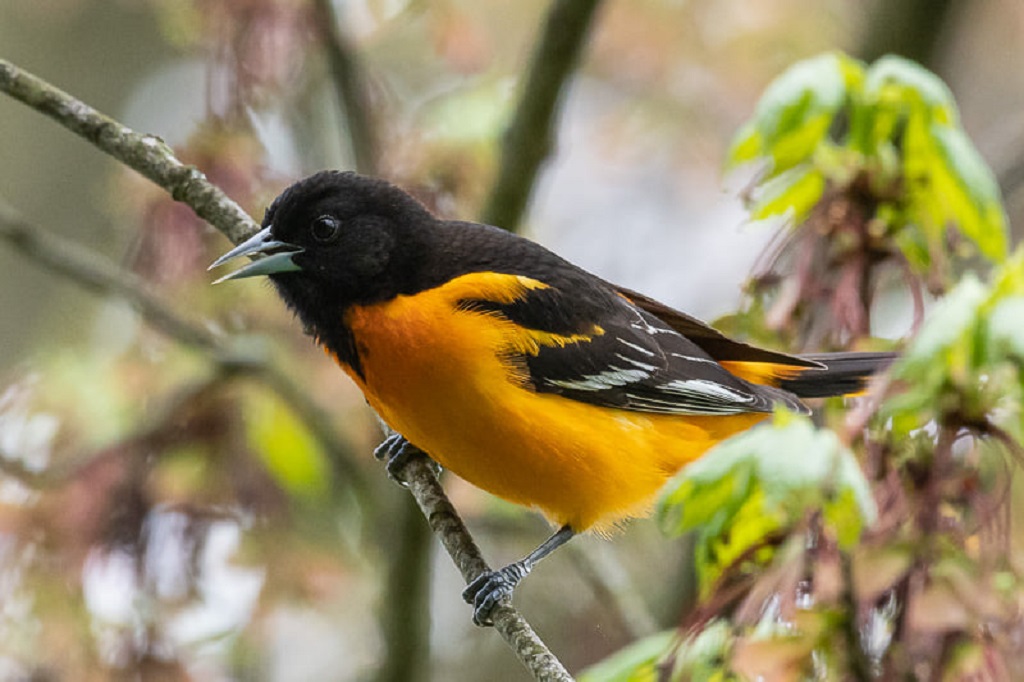
The orchard oriole (Icterus spurius) is a small migratory bird that can be found in Mississippi during the breeding season. It measures about 6.3-7.1 inches (16-18 cm) in length and weighs around 0.7-1.0 ounces (20-28 grams).
Male orchard orioles have a bright yellowish-orange plumage with black wings and tail. Females have a duller yellow coloration with grayish wings and tail. They have a slender bill and a relatively short tail.
These orioles inhabit open woodlands, orchards, and forest edges. They feed on insects, nectar, and fruits. They build hanging basket-shaped nests woven from plant fibers.
22. Yellow-throated Warbler
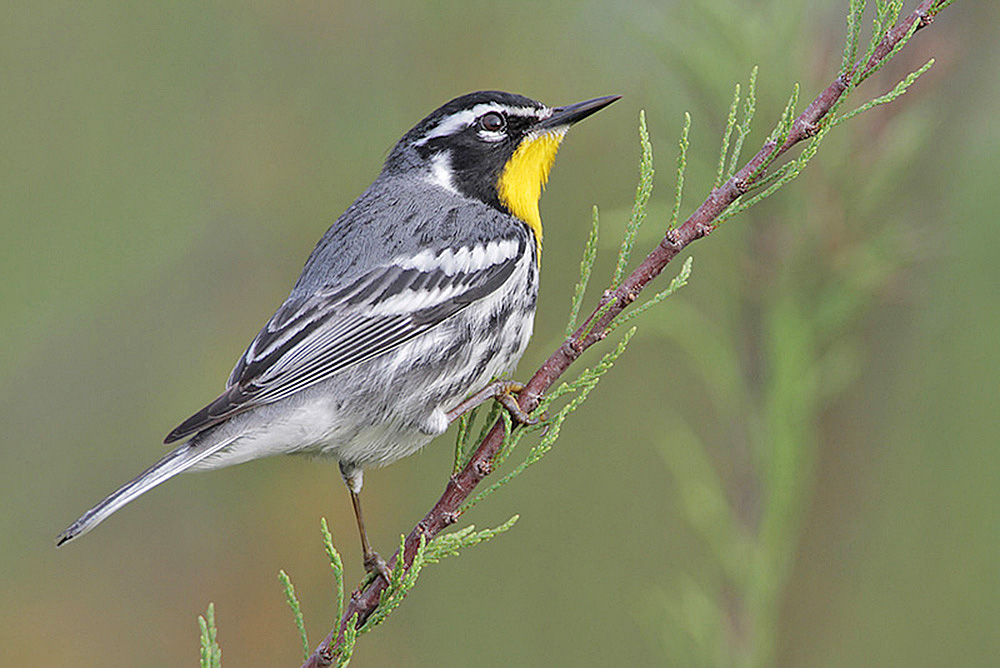
The yellow-throated warbler (Setophaga dominica) is a small migratory bird that can be found in Mississippi during the breeding season. It measures about 4.7-5.1 inches (12-13 cm) in length and weighs around 0.4-0.5 ounces (11-14 grams).
Male yellow-throated warblers have a bright yellow throat, breast, and belly, with olive-green upperparts. Females have a similar
coloration but with a slightly duller yellow throat. They have a thin bill and a relatively long tail.
These warblers inhabit mature forests, especially near water. They feed on insects and spiders. They build cup-shaped nests in the fork of tree branches.
23. American Goldfinch
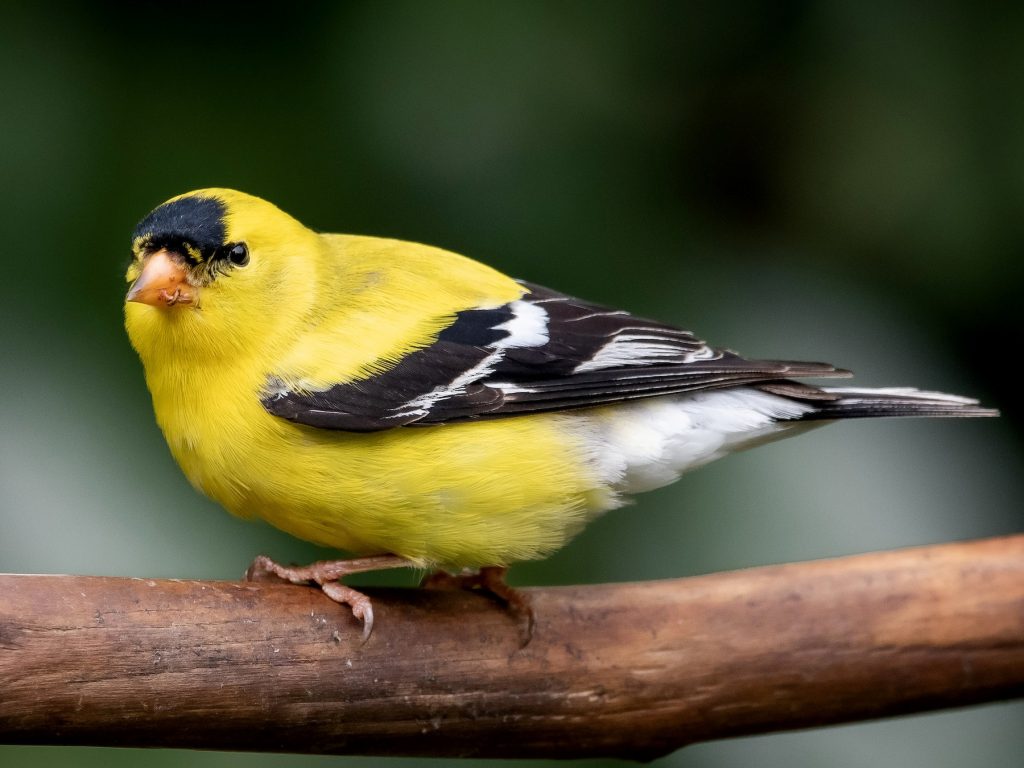
The American goldfinch (Spinus tristis) is a small migratory bird that can be found in Mississippi year-round. It measures about 4.3-5.1 inches (11-13 cm) in length and weighs around 0.4-0.6 ounces (11-17 grams).
Male American goldfinches have a bright yellow body with black wings and tail during the breeding season. Outside of the breeding season, males and females have a more olive-brown coloration. They have a conical bill and a relatively short tail.
These goldfinches inhabit open fields, meadows, and gardens. They feed primarily on seeds, especially thistle seeds. They build cup-shaped nests made of plant fibers.
24. Prothonotary Warbler

The prothonotary warbler (Protonotaria citrea) is a small migratory bird that can be found in Mississippi during the breeding season. It measures about 4.5-5.1 inches (11-13 cm) in length and weighs around 0.3-0.4 ounces (9-12 grams).
Prothonotary warblers have a bright yellow body with a bluish-gray back and wings. They have a relatively long bill and a short tail. Their song consists of a series of clear notes.
These warblers inhabit swamps, wetlands, and forested areas near water. They feed on insects and spiders. They build cup-shaped nests in tree cavities or nest boxes.
25. Hooded Warbler
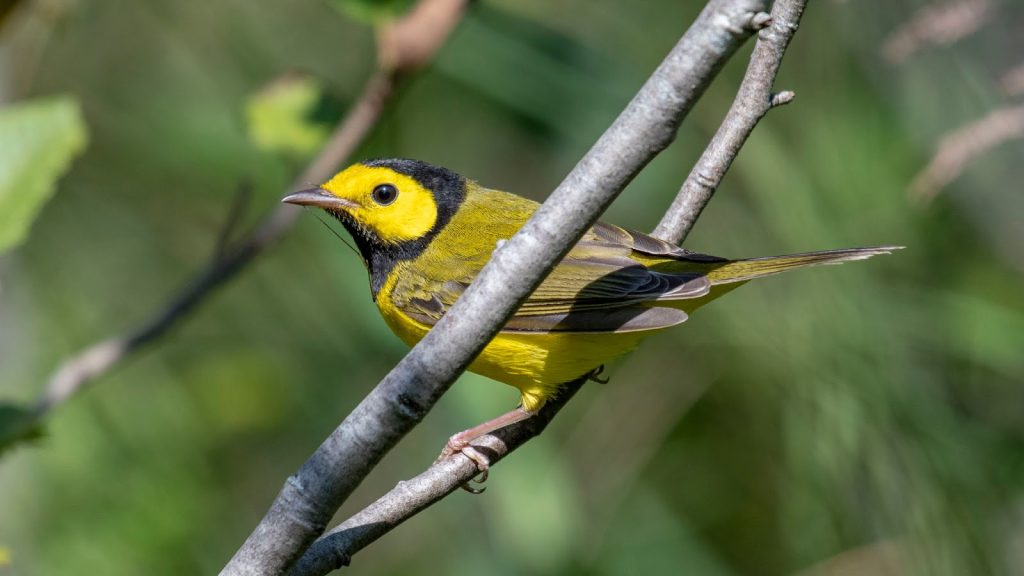
The hooded warbler (Setophaga citrina) is a small migratory bird that can be found in Mississippi during the breeding season. It measures about 4.7-5.1 inches (12-13 cm) in length and weighs around 0.3-0.4 ounces (9-12 grams).
Male hooded warblers have a bright yellow face, throat, and upper breast, with a black hood and olive-green back and wings. Females have a duller yellow coloration with a gray hood. They have a thin bill and a relatively short tail.
These warblers inhabit deciduous forests, thickets, and forest edges. They feed on insects and spiders. They build cup-shaped nests on or near the ground.
26. Yellow Warbler
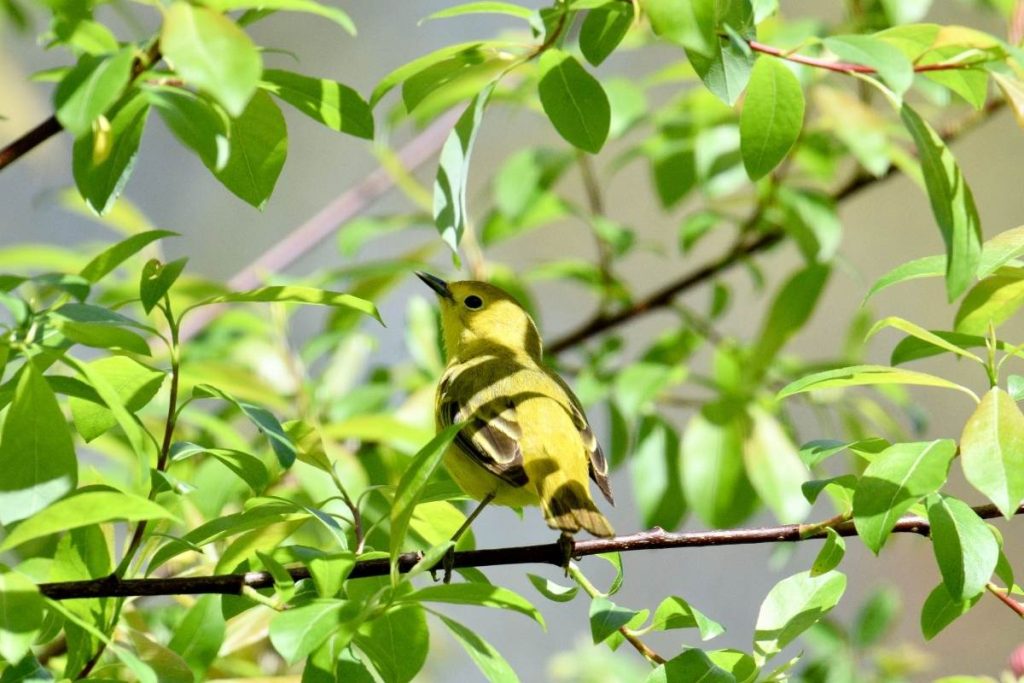
The yellow warbler (Setophaga petechia) is a small migratory bird that can be found in Mississippi during the breeding season. It measures about 4.7-5.1 inches (12-13 cm) in length and weighs around 0.3-0.4 ounces (9-12 grams).
Male yellow warblers have a bright yellow body with reddish streaks on the breast and belly. Females have a duller yellow coloration. They have a thin bill and a relatively long tail.
These warblers inhabit open woodlands, marshes, and forest edges. They feed on insects and spiders. They build cup-shaped nests woven from plant fibers.
27. Yellow-billed Cuckoo

The yellow-billed cuckoo (Coccyzus americanus) is a medium-sized migratory bird that can be found in Mississippi during the breeding season. It measures about 11-12.2 inches (28-31 cm) in length and weighs around 1.5-2.2 ounces (42-62 grams).
Yellow-billed cuckoos have a mainly grayish-brown plumage. They have
a long tail with white spots on the underside. They also have a yellow bill and red around the eye. Their song is a series of low, guttural notes.
These cuckoos inhabit forested areas, especially near water. They feed on insects, especially caterpillars. They build platform nests made of twigs.
28. Northern Flicker
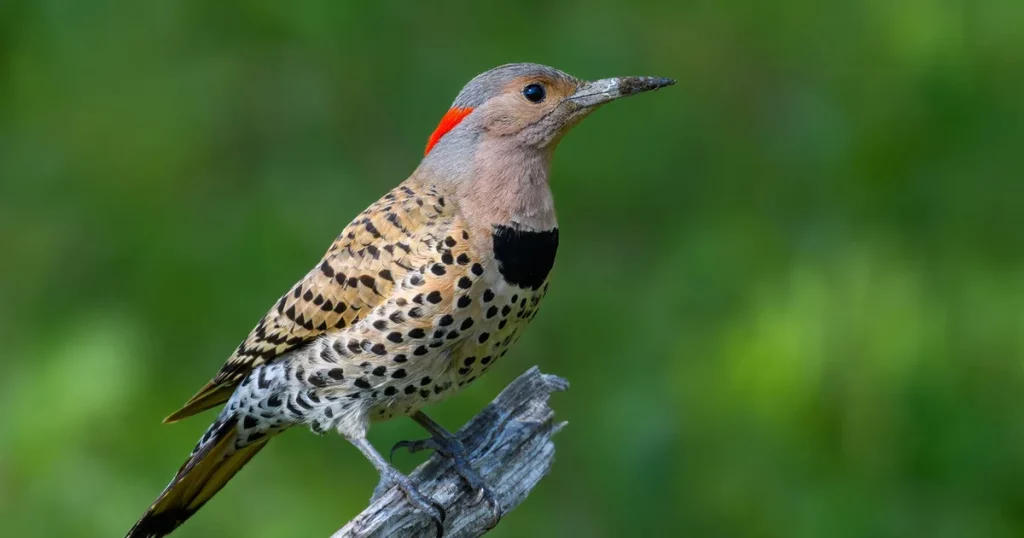
The northern flicker (Colaptes auratus) is a medium-sized migratory bird that can be found in Mississippi year-round. It measures about 11-14 inches (28-36 cm) in length and weighs around 3.9-5.6 ounces (110-160 grams).
Male northern flickers have a brownish body with black bars on the back and wings. They have a yellow or red crescent on the nape and a black bib on the chest. Females have a similar coloration but lack the black bib. They have a long bill and a relatively long tail.
These flickers inhabit open woodlands, forest edges, and suburban areas. They feed on insects, ants, and beetles. They build cavity nests in trees or use existing cavities.
29. Yellow-bellied Sapsucker
The yellow-bellied sapsucker (Sphyrapicus varius) is a medium-sized migratory bird that can be found in Mississippi during the winter season. It measures about 7.9-8.7 inches (20-22 cm) in length and weighs around 1.5-1.9 ounces (42-54 grams).
Male yellow-bellied sapsuckers have a black and white plumage with a red throat, black chest, and yellow belly. Females have a similar coloration but with a white throat and belly. They have a stout bill and a relatively short tail.
These sapsuckers inhabit forests, woodlands, and orchards. They feed on sap, insects, and tree fruits. They excavate holes in trees to feed on sap and also use the holes for nesting.
30. Yellow-rumped Warbler
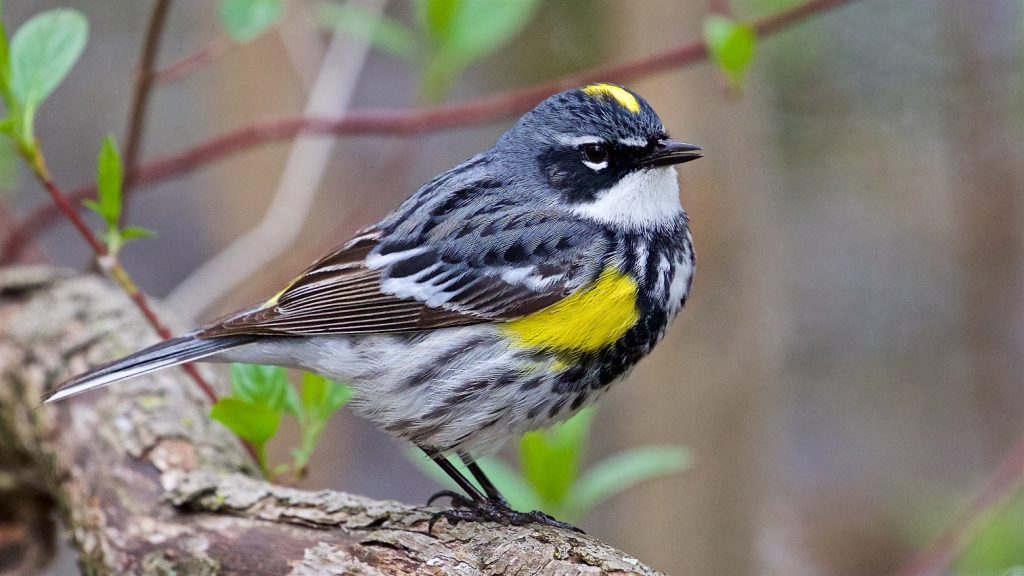
The yellow-rumped warbler (Setophaga coronata) is a small migratory bird that can be found in Mississippi during the winter season. It measures about 4.7-5.9 inches (12-15 cm) in length and weighs around 0.4-0.6 ounces (11-17 grams).
Male yellow-rumped warblers have a grayish body with a yellow throat, rump, and sides. They also have a white belly and black streaks on the sides. Females have a similar coloration but with a duller yellow throat. They have a thin bill and a relatively long tail.
These warblers inhabit various habitats, including forests, woodlands, and open areas. They feed on insects and berries. They build cup-shaped nests made of plant fibers.
31. Yellow-crowned Night Heron
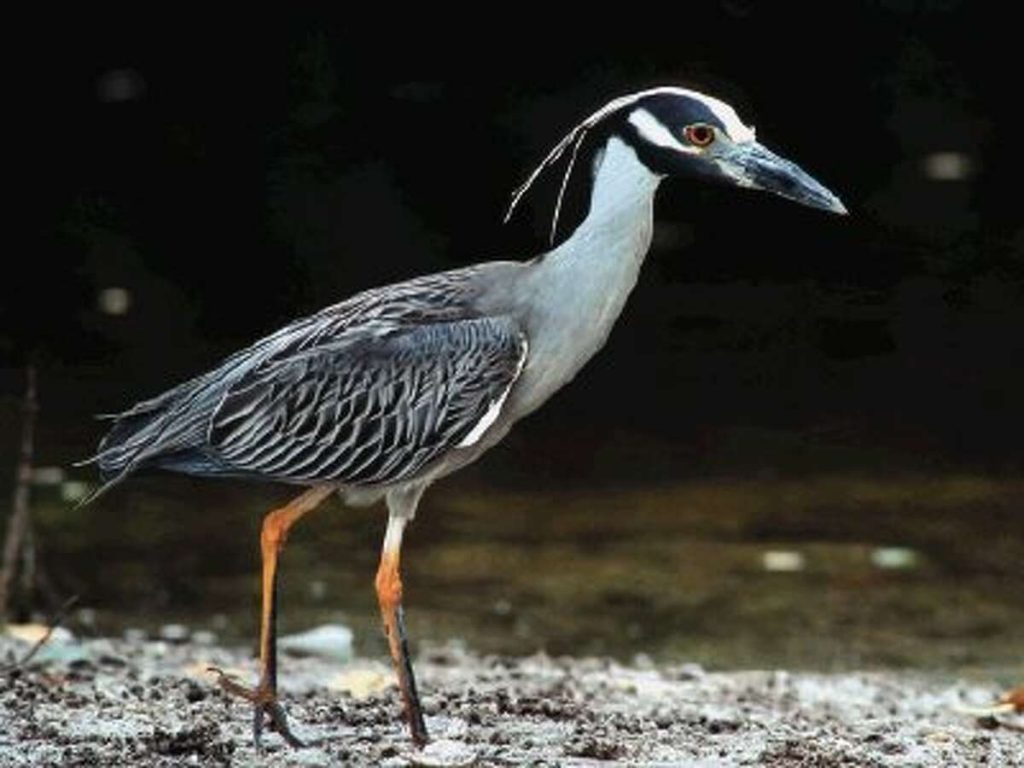
The yellow-crowned night heron (Nyctanassa violacea) is a medium-sized wading bird that can be found in Mississippi year-round. It measures about 23-28 inches (58-71 cm) in length and weighs around 1.6-2.2 pounds (700-1000 grams).
Yellow-crowned night herons have a mainly gray body with a black crown and a yellowish-white stripe below the eye. They also have a long neck, a thick bill, and yellow legs. Their call is a loud squawk.
These herons inhabit wetlands, marshes, and coastal areas. They feed on a variety of prey, including fish, crustaceans, and insects. They build platform nests made of sticks in trees or shrubs.
32. Yellow-crowned Parrot
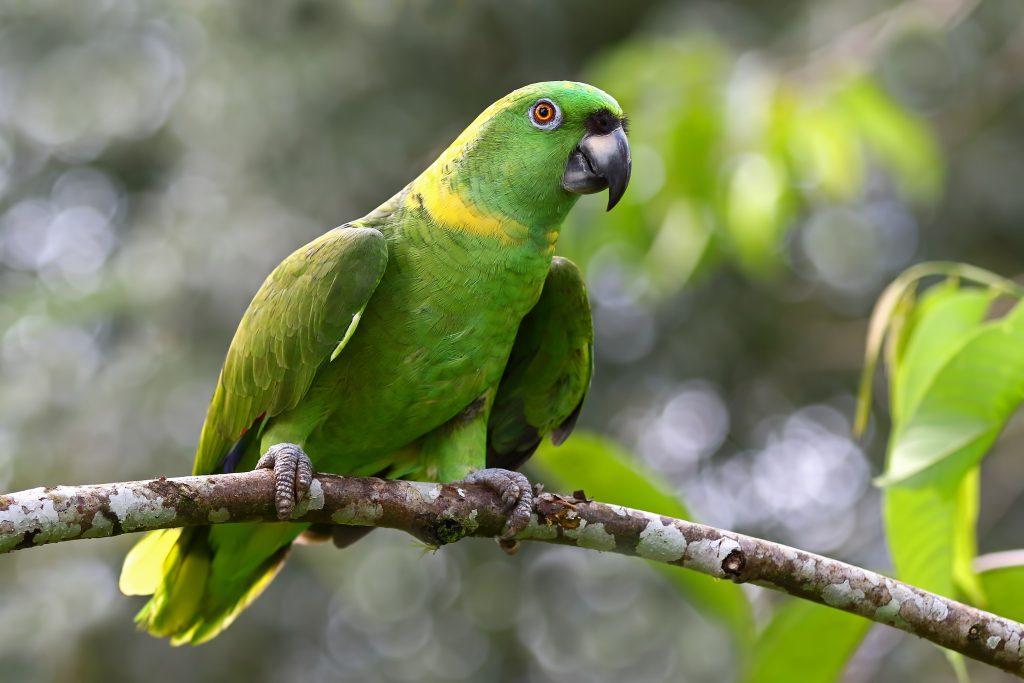
rot (Amazona ochrocephala) is a medium-sized parrot species that can be found in Mississippi as an escaped or released pet. It measures about 14-15 inches (35-38 cm) in length and weighs around 9-14 ounces (250-400 grams).
Yellow-crowned parrots have a predominantly green plumage with a yellow head and crown, a red patch on the shoulder, and a blue tail. They have a hooked bill and strong feet for climbing. Their call is a series of loud squawks and screeches.
These parrots can be found in urban areas, parks, and forested regions. They feed on fruits, seeds, nuts, and occasionally flowers. They nest in tree cavities.
33. Yellow-chevroned Parakeet
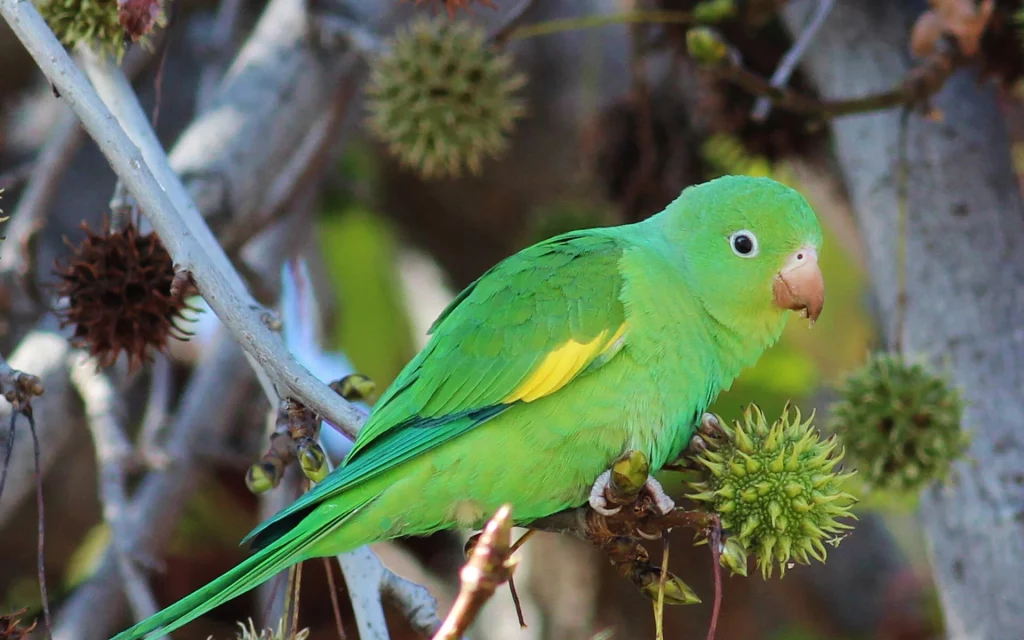
The yellow-chevroned parakeet (Brotogeris chiriri) is a small parrot species that can be found in Mississippi as an escaped or released pet. It measures about 9-10 inches (23-26 cm) in length and weighs around 2-3 ounces (55-85 grams).
Yellow-chevroned parakeets have a predominantly green plumage with a yellow head and yellowish-green cheeks. They have a short tail and a relatively large beak. Their call is a high-pitched, repetitive chirping sound.
These parakeets can be found in urban areas, parks, and forested regions. They feed on fruits, seeds, nuts, and flowers. They nest in tree cavities or nest boxes.
Please note that while some of these bird species are commonly found in Mississippi, others may be less common or occur as occasional visitors.
.
